An Overview of the Dürer’s Engravings for Sale at Bonhams in London
(by the art historian Giulia Santoro)
On the 18th of December, Bonhams auction house in London presents the Print and Multiple sale, with a wide selection of engravings, etchings, lithographs and other printmaking techniques ranging from the Renaissance to the Contemporary Art.
Collectors will find Old master prints by great Northern artists such as Rembrandt and Hendrick Goltzius, and also outstanding works by the modern and contemporary masters including Piranesi, Goya, Chagall, Mirò, Picasso, Warhol, Hirst and many others. Among the lots in the catalogue there are remarkable engravings by the German artist Albrecht Dürer (1471-1528).
Born in the southern German city of Nuremberg, Dürer became apprenticed at the age of 15 to the Nuremberg painter and printmaker Michael Wolgemut. Wolgemut undoubtedly encouraged Dürer’s interest in printmaking, and engraving and woodcut soon became the young artist's preferred media. By 1494 Dürer had established his own workshop in Nuremberg from which he produced engravings woodcuts and, later, illustrated books of exceptional quality covering a wide range of subjects, from devotional images to works of esoteric philosophical content.
Here are some among the most interesting highlights of the sale we have selected for your pleasure:
 |
Albrecht Dürer, Four Naked Women (Bartsch 75; Meder, Hollstein 69; Schoch, Mende and Scherbaum 17) Engraving, 1497, on laid paper with watermark Gothic P, a fine Meder b impression, trimmed on or just inside the borderline, a horizontal fold with skillful touches of pen and ink running across the knees of the two women on the right, a tiny rust plughole on the upper right hip of the woman on the left. Sheet 189 x 131mm. (unframed). This is one of Dürer’s earliest signed prints bearing a date before 1503. In the engravings produced between 1496 and 1502, the rapid development of his technique with the burin is astonishing. In the treatment of female nudes the precise line and sensitive modeling of flesh become more and more detailed, and by establishing a middle tone for the background with extremely fine parallel lines, he exploits a broad range of light and dark tonalities. The delicacy of his line and the refinement of the dense shading produce an effect of softly reflected light bathing truly three-dimensional forms. |
This work shows four naked women, reflecting Dürer’s interest for classical iconography. Since his symbolism is often Neoplatonic, the engraving can be interpreted as an enigmatic image of Venus and the Graces. In order to the Italian Neoplatonism, the Three Graces were the symbol of the grace of God unfolded into three phases of Christian Grace, prevenient illuminant, and perficient grace, or Platonic Beauty as unfolding into Beauty, Love and Pleasure. See Price Estimate
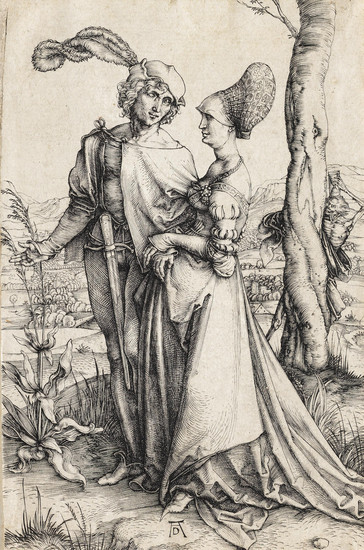 |
Albrecht Dürer, The Promenade (Bartsch 94; Meder, Hollstein 83; Schoch, Mende and Scherbaum 19) Engraving, circa 1498, on laid paper without watermark, a very good, rich Meder I a/b impression, with light plate tone and burr to the bunch of grass in the lower left corner, trimmed on or just inside the irregular borderline on three sides, trimmed 10mm. inside the subject in the upper sheet, a very skillfully re-attached area in the sky to the right of the trunk, and other minor repairs. Sheet 184 x 119mm. (unframed) This virtuoso engraving shows a young couple strolling in a pleasant landscape. But behind the three to the right, there is the personification of Death scowling in their direction, holding aloft a vanitas symbol in the form of an hourglass. Although the meaning of this print has not been satisfactorily explained, it is clear that the image is a memento mori, a reminder of the mortality and brevity of life. See Price Estimate |
|
 |
Albrecht Dürer, Apollo and Diana (Bartsch 68; Meder, Hollstein 64; Schoch, Mende and Scherbaum 38) Engraving, circa 1502, on laid paper with a partial Bull’s Head watermark (M.62), a good, strong Meder c impression, printing with contrast, trimmed to the platemark below and just inside on three sides, a horizontal repaired tear across the centre of the sheet with tiny touches of pen and ink. Sheet 114 x 71mm. (unframed) Dürer made many proportional studies of nudes, of which a number remain. This is one of his most clearly classical engraving representing idealized nude figures; the standing Apollo firing arrows has been said to derive from drawings or prints of the Apollo Belvedere. The influence of Mantegna's sculptural effects is also evident. The seated figure of Diana is thought to have been influenced by an engraving of the same subject by the Italian artist Jacopo de Barbari. Devoted to the hunt, the chaste goddess is accompanied by a deer, partially covered by the figure of Apollo. See Price Estimate |
 |
Albrecht Dürer, Sol Justitiae - The Judge (Bartsch 79; Meder, Hollstein 73; Schoch, Mende and Scherbaum 23) Engraving, circa 1499, on laid paper without watermark, a good Meder c impression, with the scratches descending to the left and right shoulders, trimmed just inside the borderline, a short repaired tear with associated thinning at the left center sheet above the lion’s right eye. Sheet 105 x 76mm. (unframed) This engraving is a good example of Dürer’s ability to transform mythological personifications into Christian symbols. The supreme sun god, Sol Iustitiae, enthroned on a lion was described by late medieval encyclopedists as a counterpart to the Son of Man before John in the first chapter of Revelations: “The Sun of Righteousness shall appear ablaze when he will judge mankind on Doom’s Day, and he shall be burning and grim. For as the sun burns the herbs and flowers in the summertime when he is in the Lion, so Christ shall appear as a fierce and lion-like man in the heat of judgment and shall wither |
the sinners.” To complete the image of Christ the judge as Sol Iustitiae, Dürer added the sword of justice in his right hand and the scales in his left. See Price Estimate
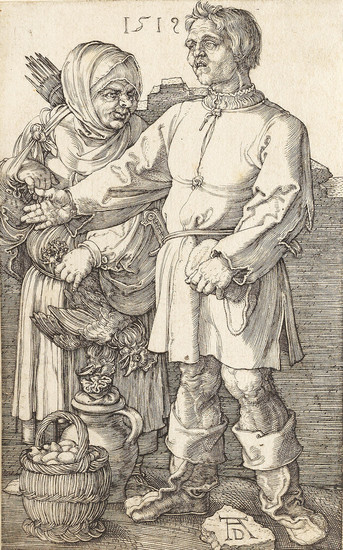 |
Albrecht Dürer, The Peasant and his wife at market (Bartsch 89; Meder, Hollstein 89; Schoch, Mende and Scherbaum 88) Engraving, 1519, on laid paper without watermark, a very good Meder b impression, trimmed on or just outside the borderline on two sides, trimmed on or just inside the platemark at right and below but retaining a fillet of paper, in good condition. Sheet 116 x 73mm. (unframed) Dürer dedicated to a peasant subject many engravings, in particular shortly before his journey to the Netherlands (1520-21). This print probably served on the journey as a gift for one of his Dutch hosts. The striking aspect of the image is the artist’s meticulous observation of every detail, reflecting his lively interest in the genre scene. But if we look closer we can see an unexpected citation of the antique. The classical gesture of the male peasant reminds to the typical poses of Roman soldiers, for instance, those found on sarcophagi. In his peasant engravings, Dürer invents nothing less than a new iconographic mode of art: the inverse citation. He exercises great skill in concealing his “citation,” while at the same time displays his ironic intention. See Price Estimate |
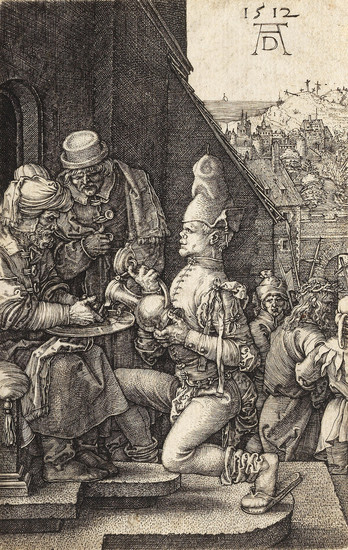 |
Albrecht Dürer, Pilate washing his Hands, from The Engraved Passion (Bartsch 11; Meder, Hollstein 11; Schoch, Mende and Scherbaum 53) Engraving, 1512, on laid paper without watermark, a very good, Meder an impression, trimmed inside the platemark, generally in good condition. Sheet 115 x 74mm. (unframed) In 1512 Dürer issued his Engraved Passion with fifteen plates, each signed and dated, originally published without a text as a collector’s item. The engraving, which is part of this series, shows Pontius Pilate seated on a throne and washing his hands over a basin with a servant pouring water over his hands, while Christ, represented to the right background, is being led away by soldiers. Designed more for the pleasure of intellectual art lover than for the pious response of the devout, the Engraved Passion is clearly a production for a new species of art patron. The fact that a number of editions were later hand-colored also suggests that the engravings were to be valued as precious works of art much as some of the sumptuous Book of Hours were at an earlier age. |
For the more aesthetic pleasures of the wealthy collector, Dürer exploited the intricate details of exotic costumes, like the extravagant garments of the servant, and the subtle tonal transitions in the modeling of figures in space and light. See Price Estimate
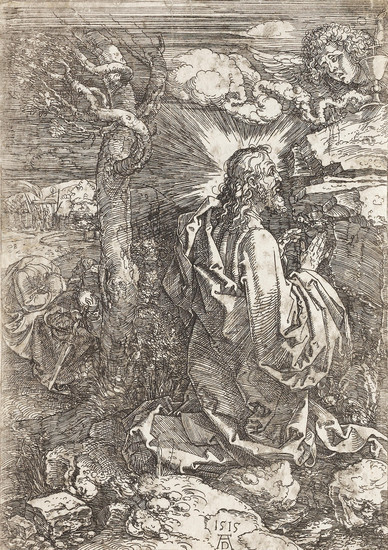 |
Albrecht Dürer, Agony in the Garden (Bartsch 19; Meder, Hollstein 19; Schoch, Mende and Scherbaum 80) Etching, 1515, on laid paper without watermark, a Meder IIa/b impression printing with rust spots, trimmed inside the platemark but retaining a fillet of paper outside the borderline, several repaired tears, the upper and tip of the lower left corners made-up with touches of ink and pen. Sheet 223 x 156mm. (unframed) This is one of only six etchings that Dürer produced with a different technique. It still consists in an intaglio process, but the incised lines are produced mechanically, with the aid of an acid-resisting ground first laid on the plate, and a bath of acid which bites into the plate only where the artist has drawn his design with the etching-needle and so removed the protective ground. In this work, Dürer takes advantage of the new etching technique in order to blend the clair-obscur effects of the preceding phase with the expressive literalism and grand pathos of the Passion. See Price Estimate |
This article was brought to you by the art historian Giulia Santoro in collaboration with Lot-Art.com
Lot-Art offers direct links to the most reputable auction houses and bidding platforms worldwide, to easily browse through all auctions from a single portal. Lot-Art Investment Advisory can leverage on its extensive database, expertise, and international network to assist new and established collectors in acquiring quality artworks which are also sound financial investments. Join us today for the best auctions browsing experience!
The LOT-ARTeam
LOT-ART | Worldwide Auctioning Made Easy
Other interesting articles
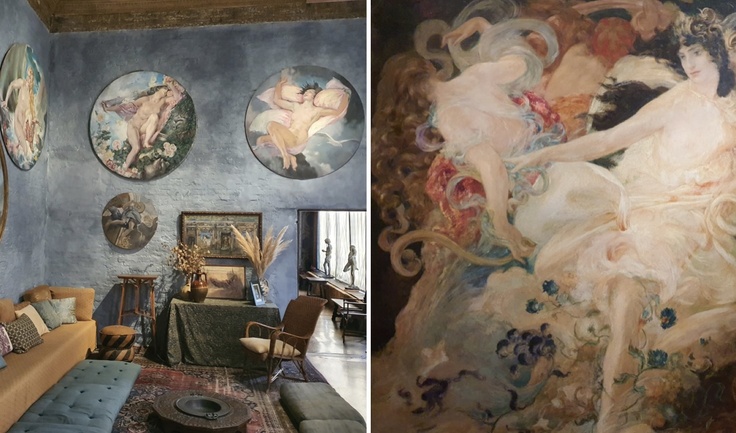
|
Mon Apr 22 2024
Enchantment at Palazzo Fortuny: 'Selva' by Eva Jospin in VeniceLEFT: Photograph of the Mariano Fortuny Y Madrazo Museum; RIGHT: Wagnerian Cycle. Parsifal. The Flower Maidens, Mariano Fortuny y Madrazo, 1896 Mariano Fortuny y Madrazo, born in Granada in 1871, was a renowned Spanish artist celebrated for his innovative contributions in the realms of fashion, photography, and lighting design. Fortuny gained global fame for the... |
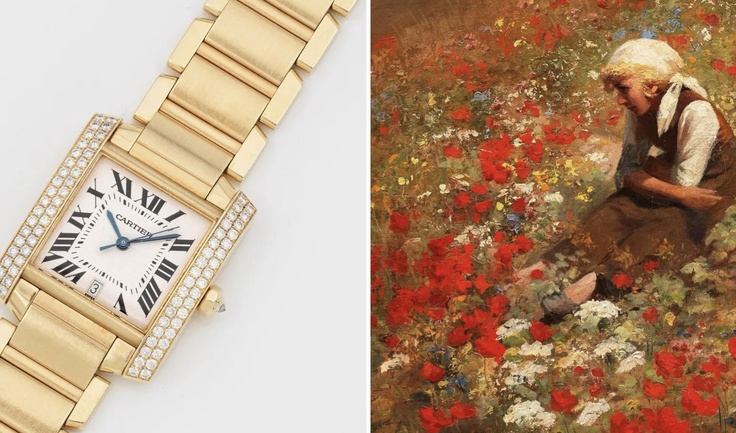
|
Sat Apr 20 2024
International Art at Schloss Ahlden, GermanySchloss Ahlden, Germany presents the 190th International Art Auction in four parts: Part I on 27 April Part II on 28 April Part III on 3 May Part IV on 4 May Discover the Auction Highlights or browse the full catalogues here » SELECTED LOTS LEFT: Lovis Corinth (1858 - 1925) - "Pair of Centaurs" Oil on canvas, laid down on canvas. Signed and dated 1917. See Date & Price... |
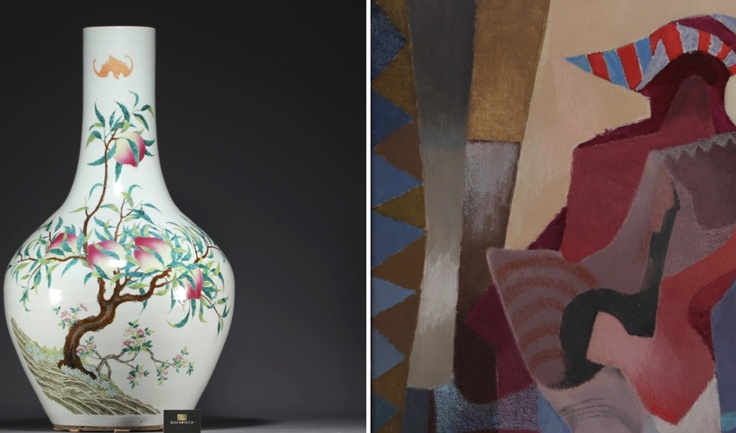
|
Fri Apr 19 2024
Fine & Decorative Art at Goldfield, LuxembourgGoldfield, Luxembourg presents the Auction 'Succession of Baron Lejeune & Miscellaneous' on April 27th. The catalogue features fine art, Asian and ethnographic art, jewellery & watches, silverware, design and classic furniture. Discover the Auction Highlights or browse the full catalogue here » SELECTED LOTS LEFT: Michelangelo Barberi (1787-1867) attr. - Marble table... |

|
Wed Apr 17 2024
Post-War & Contemporary Art at Venduehuis der NotarissenVenduehuis der Notarissen presents the April Auctions: Post-War & Contemporary Art on 8 – 23 April (Online Auction) The Lucassen Collection Part 1 on 24 April (Hammer Auction) The Lucassen Collection Part 2 on 8 – 25 April (Online Auction) Discover the Auction Highlights or browse the full catalogues here » SELECTED LOTS LEFT: Marlene Dumas (1953) - "Fear of Babies" The... |